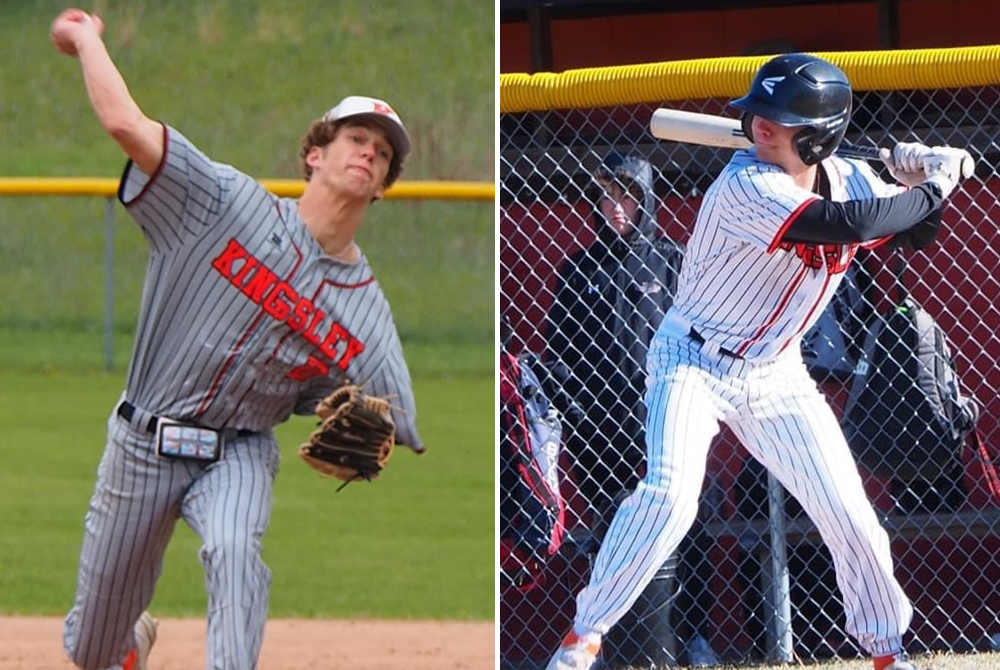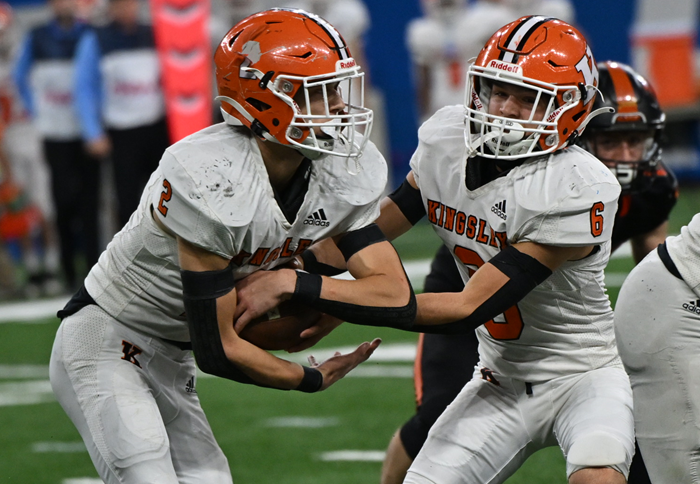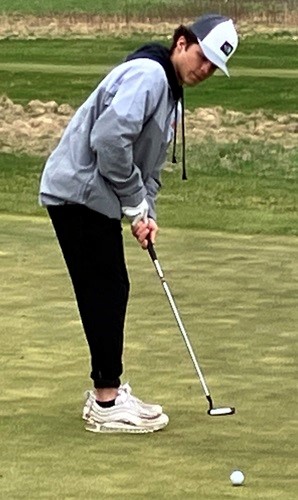
Glad to Bring Baseball Back to Gladstone
May 9, 2013
By Geoff Kimmerly
Second Half editor
Blake Ballard looked out at the snow covering Gladstone last month and figured it would never melt. When he and his teammates finally played in their first tournament of the season April 20, the temperature couldn’t have broken 30 degrees.
It’s the annual plight of a high school baseball player. And Ballard and teammates are glad to enjoy it for the first time – as members of Gladstone’s first high school baseball team since 1959.
The Braves made their re-debut last month thanks to a full community effort that included deft advising from the eventual coach, creative thinking by the administration and school board and enthusiastic fundraising by parents and supporters – none of which is lost on a group of athletes who are off to a 10-3 start heading into Thursday’s doubleheader against Escanaba.
“Once we figured out it was going to happen, we were excited. Kids started practicing a lot,” said Ballard, one of the team’s two seniors. “It’s going to be pretty sweet later on. Whoever didn’t (play) will regret it.”
Gladstone has roughly 5,000 residents, and baseball has remained a staple of the community over the last half century – just not as the high school level.
Children grow up playing in the local little league and on travel teams, and then graduate to American Legion ball when they are older. But for any number of reasons – including weather-related difficulties in scheduling, low interest or lack of facilities – only 19 Upper Peninsula MHSAA high schools offer baseball.
At Gladstone, boys instead played and can continue to choose from track and field, golf and tennis during the spring. Ballard, for example, was a golfer before getting his chance on the diamond this year.
A football and basketball player too, he often was asked why his school didn't play baseball – and really had no idea how to answer.

Community members had campaigned for baseball in the past, said athletic director Matt Houle. He’s worked at Gladstone for more than 30 years, and has seen four or five strong pushes over the last decade alone.
But those efforts faced two challenges. The first was funding – all programs at Gladstone previously were funded by the school, but baseball if added would have to raise its own money. And the school also wanted to make sure to continue complying with Title IX, which meant finding more opportunities for female students as well if a baseball team was added for the boys. (Gladstone already has a softball program, and it’s one of the state’s best of the last decade with two MHSAA titles and a runner-up finish last season in Division 3.)
Enter former Escanaba baseball coach Don Lauscher.
He and two others keyed a similar effort that led to Escanaba High School creating a baseball program in 2002, and he also assisted Marquette when it added baseball four seasons ago. He had coached Gladstone Legion teams in 2005 and 2006 and Escanaba's varsity to a 130-27 record from 2007-11, but wasn't looking to become coach of a new program – he just hoped to lend his knowledge on getting it started.
Rallying the community was the easy part. And to keep with Title IX, Gladstone added self-funded co-ed swimming and bowling programs.
Supporters convinced the school board they could fund the program – and already have the team two years ahead on its expected financial obligations thanks to special events but also additional donations from local foundations and independently by other members of the community.
“Our community has always been supportive of our athletic teams. And being a town looked upon as a strong baseball/softball program, it was inevitable it would happen,” Houle said.
“People kept coming up and saying, ‘Congratulations Coach. We’re really behind you,’” Lauscher said of a recent breakfast fundraiser. “It’s amazing.”
The community is getting its money’s worth.
Ironically, an uncle of Lauscher's wife played on that 1959 Gladstone team. That didn't play into his taking over as coach, but he had other reasons.
Perhaps most of all, Lauscher missed teaching the game. He's coached it at just about every youth level and attended clinics as far away as Georgia and Louisiana, and enjoys passing on what he's learned. And life events fell into play to allow the opportunity to be assisted by his son Kurt and nephew B.J.; both played at Grand Rapids Community College and Kurt also pitched at Central Michigan University.
Again, because of the summer programs, Lauscher didn’t start completely from scratch. A core group including Ballard, juniors Christian Groleau, Christian Tackman, Sam Pouliot and sophomore Justin Jurek gave the Braves a quality pitching staff and some high school-comparable experience. Still, the team didn't have a catcher when practice began and fundamentals have been the focus as the coaches bring everyone up to speed.
As a whole, the 14-player roster has caught on quickly.
“Seeing the things these kids didn't know to where they are now, I’m very surprised where they are now,” Don Lauscher said.
The team plays at its local Legion field, which has lights and is only about a quarter-mile from the school. The Braves hosted their first “Parents Night” last week and truly are inclusive of the full student body with Lucas LaCosse joining Ballard as the seniors, followed by five juniors, four sophomores and two freshmen.
Gladstone’s other spring sports haven’t lost out much, if at all. The track and field team has 41 athletes and the golf team has 16; the tennis team is down to 11, but graduated a large senior class last season.
More Upper Peninsula schools are talking about adding baseball and softball, Houle said; Hancock softball played its first games ever Wednesday. Schools looking to get a program together would be wise to follow Gladstone’s road map.
“There is so much enthusiasm for it right now,” Houle said. “Just being at the diamond around kids I know so well, to see in their faces the excitement ... I’m very honored. There’s a great sense of pride among these kids.”
After the team's first four dates were canceled, Ballard threw the first game of Gladstone High's modern history.
“It was weird. (But) everyone liked it," he said. "It seemed like a big difference, playing for our school now."
PHOTOS: (Top) Christian Tackman (10) prepares to throw to first base while shortstop Blake Ballard follows behind during a game this spring. (Middle) Gladstone catcher Justin Jurek looks toward the dugout for a signal. (Photos courtesy of Lori Jurek).

Kingsley Standouts Big Hits on Diamond, as Friends to 4th-Hour Classmates
By
Tom Spencer
Special for MHSAA.com
April 19, 2024
When Eli Graves or Gavyn Merchant takes a swing this spring for Kingsley, a special group of friends are not worried how they’ll connect with the ball.
 That group of friends and classmates — students in Joel Guy’s fourth-hour special education class — feel like the two senior standout athletes already hit a home run at school that day. It might even feel like a grand slam from Graves or perhaps a hole-in-one for Merchant.
That group of friends and classmates — students in Joel Guy’s fourth-hour special education class — feel like the two senior standout athletes already hit a home run at school that day. It might even feel like a grand slam from Graves or perhaps a hole-in-one for Merchant.
And the Kingsley baseball and golf coaches feel similarly – and sentiment that may extend through the entire Kingsley community.
Merchant and Graves are playing their final baseball seasons with Stags. Merchant is dual-sporting, adding golf to his incredible athletic career.
Together, they led the Stags to Division 6 football championship in the fall despite battling through extensive injuries. Graves, the star running back, and Merchant, the outstanding quarterback, then fought through long, hard rehabilitations to get back and lead the Stags on the hardcourt and wrestling mats this winter.
But before stepping up to the plate or the tee to compete for Kingsley on any given day this spring, the pair spend time in Guy’s class and share lunch with the Kingsley cognitively impaired (CI) students.
“You can’t say enough good things about these young men,” said Guy, who also is in his fourth year as the Kingsley golf coach. “I get teary-eyed talking about it – they just kind of took a hold of some of my students making contact at lunch and in the hallway.”
That contact began midway the football season. Graves and Merchant were joined by fellow golfer Ty Morgan and football teammate Skyler Workman.
 A few more senior athletes have been a part of the adoption of Guy’s students intermittently as well. But Guy’s students can count on seeing Graves, Merchant, Morgan and Workman in the classroom each and every day and then at lunch. The time was made possible, Guy notes, because the athletes are ahead in their own academic pursuits or participants in the school’s Teacher Academy program.
A few more senior athletes have been a part of the adoption of Guy’s students intermittently as well. But Guy’s students can count on seeing Graves, Merchant, Morgan and Workman in the classroom each and every day and then at lunch. The time was made possible, Guy notes, because the athletes are ahead in their own academic pursuits or participants in the school’s Teacher Academy program.
How those seniors are contributing is rare for accomplished athletes in a high school setting, Guy is happy to point out.
“Gavin and Eli are state champions in football,” said Guy. “They are the stars of their winter sports basketball and wrestling, and you you think that being seniors with those kinds of credentials at lunch they would sit in a table with all their buddies and talk about their accomplishments.
“They sit with my special education students,” Guy continued. “They make my students feel like they’re the ‘in’ crowd, and I am so proud of them.”
Bruce Graves, father of Eli and coach of the Stags’ baseball team, recalls learning from Guy what that group of seniors was doing with their fourth hour. He wasn’t really surprised to hear from someone else what his senior leaders were doing.
“They wouldn’t tell anybody they were doing it,” the 22-year veteran coach said. “They don’t do it for a pat on the back – they just do it because they like being good guys.”
There are various reports of exactly how the athletes started getting involved with the special education students. But everyone in the school located 15 miles south of Traverse City seems happy they did.
Eli Graves, one of the Stags’ five pitchers, roams center field when he’s not on the mound. He is 1-0 as the Stags are off to a 9-0 start following a conference sweep of Kalkaska, 3-0, 15-0, on Thursday. The right-hander is slated to pitch this weekend and has hopes of the Stags finishing the year with a conference baseball title and a deep postseason run.
Graves and Merchant have raised money all year to get birthday and Christmas gifts for their classmates in Guy’s room. They’ve become particularly close to a couple of his students.
“They don’t really see us as helpers or anything like that — they see us more as friends,” said Graves, now playing his third year on the varsity baseball squad. “We go into the special ed room, and basically just help the students with whatever work they are doing.”
 After recovering from football injuries, Graves averaged more than 15 points per game this basketball season and earned all-conference. Merchant also recovered from postseason surgeries and got back on the mat to place fourth at 132 pounds in Division 3 and became an all-state wrestler for the fourth time.
After recovering from football injuries, Graves averaged more than 15 points per game this basketball season and earned all-conference. Merchant also recovered from postseason surgeries and got back on the mat to place fourth at 132 pounds in Division 3 and became an all-state wrestler for the fourth time.
The pair’s in-season football injuries were not known to many. They wanted to compete for the state title and tend to the injuries later. Graves rushed for almost 2,000 yards, tying and breaking some of his brother Owen’s school records along the way. He also had 20 tackles, two interceptions and four touchdowns on defense during the 2023 campaign.
Graves sprained a shoulder joint during the Semifinal win over Reed City but a week later carried the ball 33 times and ran for 210 yards in the title game. He had four touchdowns that day in the Stags' 38-24 victory over Almont.
Merchant has had various injuries over the course of his career, undergoing wrist surgery as a sophomore for a carpal tunnel injury and having floating cartilage taken out of a knee following his junior wrestling season.
But what he endured on the way to Ford Field was the topper as he endured two torn ligaments in his knee, a fractured leg, a torn meniscus — and, later on — a pair of broken ribs sustained late in the championship game.
“When you’re in the game, it’s all about adrenaline,” said Merchant, who is facing another surgery in May but shot a 95 to lead Kingsley in its first tournament of the season Thursday at the Frostbite Open in Manton. “You don’t even think about the injury until you get off the field, and that’s when you get ice bags and fight it off.”
They have been close friends since elementary school and credit the Kingsley coaching, teaching and counseling staffs with preparing them for life after graduation.
Graves and Merchant call football their favorite sport. Graves hopes to also play football at the college level, and Merchant expects to continue on the wrestling mat.
 Tom Spencer is a longtime MHSAA-registered basketball and soccer official, and former softball and baseball official, and he also has coached in the northern Lower Peninsula area. He previously has written for the Saginaw News, Bay County Sports Page and Midland Daily News. He can be reached at [email protected] with story ideas for Manistee, Wexford, Missaukee, Roscommon, Ogemaw, Iosco, Alcona, Oscoda, Crawford, Kalkaska, Grand Traverse, Benzie, Leelanau, Antrim, Otsego, Montmorency, Alpena, Presque Isle, Cheboygan, Charlevoix and Emmet counties.
Tom Spencer is a longtime MHSAA-registered basketball and soccer official, and former softball and baseball official, and he also has coached in the northern Lower Peninsula area. He previously has written for the Saginaw News, Bay County Sports Page and Midland Daily News. He can be reached at [email protected] with story ideas for Manistee, Wexford, Missaukee, Roscommon, Ogemaw, Iosco, Alcona, Oscoda, Crawford, Kalkaska, Grand Traverse, Benzie, Leelanau, Antrim, Otsego, Montmorency, Alpena, Presque Isle, Cheboygan, Charlevoix and Emmet counties.
PHOTOS (Top) Eli Graves, left, and Gavyn Merchant are among standouts for Kingsley’s baseball team again this spring. (Middle) Merchant (6) hands the ball off to Graves during the Division 6 championship win at Ford Field. (Below) Merchant putts during Thursday’s golf opener. (Baseball photos by Karen Middleton.)

